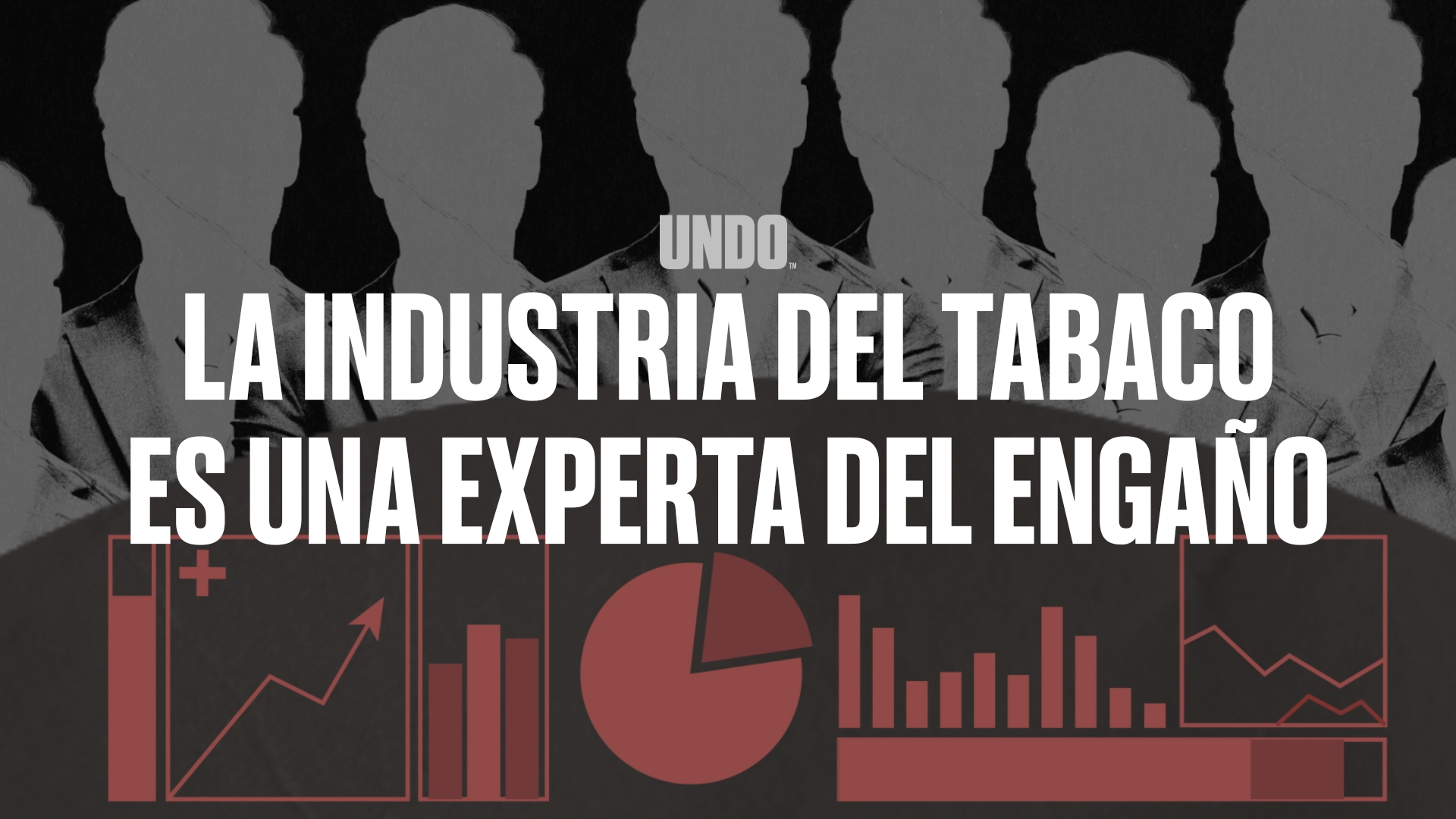Mira lo que vapear le está haciendo a tu cuerpo y a tu cerebro.
Los vapes con alta dosis de nicotina no solo pueden volverte adicto más rápido, sino que también pueden aumentar tu riesgo de padecer de cáncer, enfermedades cardiovasculares, EPOC y derrame cerebral. 12345678910111213141516171819202122232425262728
¿Qué se oculta adentro?
Los vapes vienen cargando con mucho más de lo que esperas.


Los químicos tóxicos en los vapes pueden incrementar tu riesgo de cáncer.
Los vapes pueden contener químicos que causan cáncer, como plomo, arsénico y formaldehído.1234567891011121314151617 Incluso el aerosol de vapeo de segunda mano puede contener metales pesados como cromo, níquel, manganeso y plomo poniendo en riesgo a tu familia y amigos. 351556


La nicotina y los vapes causan estragos en tu salud.
Tu cuerpo y cerebro pagan el precio, a veces, para siempre.
La nicotina es un veneno que puede intensificar la depresión y la ansiedad y modificar permanentemente la forma en que se forman las conexiones en el cerebro. 1029303132333457585960 Eso no es todo. Las personas que vapean sufren de un riesgo mayor de morir más jóvenes por derrame cerebral. 27363738 Nadie quiere este tipo de vibra.
¿Tu universidad ya está libre de tabaco y nicotina?
El Programa Universitario “California Youth Advocacy Network” colabora con estudiantes y profesores para eliminar los daños del tabaco y la nicotina en las comunidades universitarias.
Vence la nicotina, con “Outsmart Nicotine y EX Program”
Obtén asistencia gratuita las 24 horas, los 7 días de la semana, a través de mensajes de texto diarios llenos de consejos y sugerencias, una biblioteca de recursos con orientación proveída por expertos y acceso a una comunidad activa de personas que dejaron la nicotina.

Obtén más datos

El daño causado por vapear nicotina afecta:

Quiénes somos
Una California sin la Industria del Tabaco no sólo es posible, ya comenzó. Juntos estamos deshaciendo la epidemia de la Industria del Tabaco. Como parte del Departamento de Salud Pública de California, UNDO es uno de los principales programas de salud pública del país que lucha para acabar con la epidemia mortal de la Industria del Tabaco en California.
Aprende más sobre los daños que causa la Industria del Tabaco
- Aherrera A, Lin JJ, Chen R, et al. Metal Concentrations in E-Cigarette Aerosol Samples: A Comparison by Device Type and Flavor. Environ Health Perspect. 2023;131(12):127004. doi:10.1289/EHP11921
- American Cancer Society. Known and probable human carcinogens. Updated August 1, 2024. Accessed March 25, 2025. https://www.cancer.org/cancer/risk-prevention/understanding-cancer-risk/known-and-probable-human-carcinogens.html
- Fowles J, Barreau T, Wu N. Cancer and Non-Cancer Risk Concerns from Metals in Electronic Cigarette Liquids and Aerosols. Int J Environ Res Public Health. 2020 Mar 24;17(6):2146. doi: 10.3390/ijerph17062146. PMID: 32213824; PMCID: PMC7142621.
- Goniewicz ML, Knysak J, Gawron M, et al. Levels of selected carcinogens and toxicants in vapour from electronic cigarettes. Tob Control. 2014;23(2):133-139. doi:10.1136/tobaccocontrol-2012-050859
- Hess CA, Olmedo P, Navas-Acien A, Goessler W, Cohen JE, Rule AM. E-cigarettes as a source of toxic and potentially carcinogenic metals. Environ Res. 2017;152:221-225. doi:10.1016/j.envres.2016.09.026
- Kosmider L, Sobczak A, Fik M, et al. Carbonyl compounds in electronic cigarette vapors: effects of nicotine solvent and battery output voltage. Nicotine Tob Res. 2014;16(10):1319-1326. doi:10.1093/ntr/ntu078
- Liu Q, Huang C, Chris Le X. Arsenic species in electronic cigarettes: Determination and potential health risk. J Environ Sci (China). 2020;91:168-176. doi:10.1016/j.jes.2020.01.023
- National Cancer Institute. Arsenic. Updated December 5, 2022. Accessed March 25, 2025. https://www.cancer.gov/about-cancer/causes-prevention/risk/substances/arsenic
- National Cancer Institute. Chemical and Environmental Exposures: Arsenic. Updated March 2024. Accessed March 25, 2025.
- National Center for Chronic Disease Prevention and Health Promotion (US) Office on Smoking and Health. E-Cigarette Use Among Youth and Young Adults: A Report of the Surgeon General. Centers for Disease Control and Prevention (US). Published 2016. Accessed April 17, 2024. https://www.ncbi.nlm.nih.gov/books/NBK538680/pdf/Bookshelf_NBK538680.pdf
- Olmedo P, Goessler W, Tanda S, et al. Metal Concentrations in e-Cigarette Liquid and Aerosol Samples: The Contribution of Metallic Coils. Environ Health Perspect. 2018;126(2):027010. Published 2018 Feb 21. doi:10.1289/EHP2175
- Proposition 65. Lead and Lead Components. Accessed March 25, 2025. https://www.p65warnings.ca.gov/fact-sheets/lead-and-lead-compounds
- Salamanca, J.C., Meehan-Atrash, J., Vreeke, S. et al. E-cigarettes can emit formaldehyde at high levels under conditions that have been reported to be non-averse to users. Sci Rep 8, 7559 (2018). https://doi.org/10.1038/s41598-018-25907-6
- The National Institute for Occupational Safety and Health (NIOSH). Formaldehyde: evidence of carcinogenicity. Centers for Disease Control and Prevention. Updated June 6, 2014. Accessed March 25, 2025. https://www.cdc.gov/niosh/docs/81-111/default.html
- Williams M, Bozhilov K, Ghai S, Talbot P. Elements including metals in the atomizer and aerosol of disposable electronic cigarettes and electronic hookahs. PLoS One. 2017;12(4):e0175430. Published 2017 Apr 17. doi:10.1371/journal.pone.0175430
- World Health Organization. Arsenic: Key facts. Updated December 7, 2022. Accessed March 25, 2025. https://www.who.int/news-room/fact-sheets/detail/arsenic
- Zhao S, Zhang X, Wang J, Lin J, Cao D, Zhu M. Carcinogenic and non-carcinogenic health risk assessment of organic compounds and heavy metals in electronic cigarettes. Sci Rep. 2023;13(1):16046. Published 2023 Sep 25. doi:10.1038/s41598-023-43112-y
- Campaign for Tobacco-Free Kids. High Nicotine E-Cigarettes are Addicting a New Generation of Youth. Accessed April 30, 2025. https://www.tobaccofreekids.org/us-resources/fact-sheet/juul-and-other-high-nicotine-e-cigarettes-are-addicting-a-new-generation-of-youth
- Truth Initiative. Nicotine and the young brain. Published June, 2022. Accessed May 14, 2025. https://truthinitiative.org/sites/default/files/media/files/2022/06/Nicotine_Factsheet_FINAL_061722.pdf
- Mohammadi L, Han DD, Xu F, et al. Chronic E-Cigarette Use Impairs Endothelial Function on the Physiological and Cellular Levels. Arterioscler Thromb Vasc Biol. 2022;42(11):1333-1350. doi: 10.1161/ATVBAHA.121.317749.
- Espinoza-Derout J, Shao XM, Lao CJ, et al. Electronic Cigarette Use and the Risk of Cardiovascular Diseases. Front Cardiovasc Med. 2022;9:879726. Published 2022 Apr 7. doi:10.3389/fcvm.2022.879726
- Zong H, Hu Z, Li W, et al. Electronic cigarettes and cardiovascular disease: epidemiological and biological links. Pflugers Arch. 2024;476(6):875-888. doi:10.1007/s00424-024-02925-0
- Antwi GO, Rhodes DL. Association between E-cigarette use and chronic obstructive pulmonary disease in non-asthmatic adults in the USA. J Public Health (Oxf). 2022;44(1):158-164. doi:10.1093/pubmed/fdaa229
- Bhatta DN, Glantz SA. Association of E-Cigarette Use With Respiratory Disease Among Adults: A Longitudinal Analysis. Am J Prev Med. 2020;58(2):182-190. doi: 10.1016/j.amepre.2019.07.028.
- Traboulsi H, Cherian M, Abou Rjeili M, et al. Inhalation Toxicology of Vaping Products and Implications for Pulmonary Health. Int J Mol Sci. 2020;21(10):3495. Published 2020 May 15. doi:10.3390/ijms21103495
- Cardenas HL, Evanoff NG, Fandl HK, et al. Endothelial-derived extracellular vesicles associated with electronic cigarette use impair cerebral microvascular cell function. J Appl Physiol (1985). 2023;135(2):271-278. doi:10.1152/japplphysiol.00243.2023
- Patel U, Patel N, Khurana M, et al. Effect Comparison of E-Cigarette and Traditional Smoking and Association with Stroke—A Cross-Sectional Study of NHANES. Neurol Int.. 2022;14(2):441-452. doi:10.3390/neurolint14020037
- Shi J, Xiong L, Guo J, Yang Y. The association between combustible/electronic cigarette use and stroke based on national health and nutrition examination survey. BMC Public Health. 2023;23(1):697. Published 2023 Apr 14. doi:10.1186/s12889-023-15371-x
- Goriounova NA, Mansvelder HD. Short- and long-term consequences of nicotine exposure during adolescence for prefrontal cortex neuronal network function. Cold Spring Harb Perspect Med. 2012;2(12):a012120. Published 2012 Dec 1. doi:10.1101/cshperspect.a012120
- Kutlu MG, Gould TJ. Nicotine modulation of fear memories and anxiety: Implications for learning and anxiety disorders. Biochem Pharmacol. 2015;97(4):498-511. doi: 10.1016/j.bcp.2015.07.029.
- Picciotto MR, Brunzell DH, Caldarone BJ. Effect of nicotine and nicotinic receptors on anxiety and depression. Neuroreport. 2002;13(9):1097-1106. doi:10.1097/00001756-200207020-00006
- Zhao-Shea R, DeGroot S, Liu L, et al. Increased CRF Signalling in a Ventral Tegmental Area-Interpeduncular Nucleus-Medial Habenula Circuit Induces Anxiety during Nicotine Withdrawal. Nature News. 2015;Nat. Commun. 6:6770. doi: 10.1038/ncomms7770
- Lechner WV, Janssen T, Kahler CW, Audrain-McGovern J, Leventhal AM. Bi-directional associations of electronic and combustible cigarette use onset patterns with depressive symptoms in adolescents. Prev Med. 2017;96:73-78. doi: 10.1016/j.ypmed.2016.12.034.
- Obisesan OH, Mirbolouk M, Osei AD, et al. Association Between e-Cigarette Use and Depression in the Behavioral Risk Factor Surveillance System, 2016-2017. JAMA Netw Open. 2019;2(12):e1916800. Published 2019 Dec 2. doi:10.1001/jamanetworkopen.2019.16800
- Etter JF, Ussher M, Hughes JR. A test of proposed new tobacco withdrawal symptoms. 2013;108:50-59. doi:10.1111/j.1360-0443.2012.03981.x
- Poisson SN, Glidden D, Johnston SC, Fullerton HJ. Deaths from stroke in US young adults, 1989-2009. Neurology. 2014;83(23):2110-2115. doi:10.1212/WNL.0000000000001042
- Rutten-Jacobs LC, Arntz RM, Maaijwee NA, et al. Long-term mortality after stroke among adults aged 18 to 50 years. JAMA. 2013;309(11):1136-1144. doi:10.1001/jama.2013.842
- Samson K. Higher Mortality for Young Stroke Survivors. Neurology Today. 2013;13(9):19-20. doi:https://doi.org/10.1097/01.nt.0000430536.58483.d2
- Sundar IK, Javed F, Romanos GE, Rahman I. E-cigarettes and flavorings induce inflammatory and pro-senescence responses in oral epithelial cells and periodontal fibroblasts. Oncotarget. 2016;7(47):77196-77204. doi:10.18632/oncotarget.12857
- American Society for Microbiology. Evidence grows for vaping's role in gum disease. Published February 22, 2022. Accessed May 8, 2025. https://asm.org/press-releases/2022/feb-2022/evidence-grows-for-vaping-s-role-in-gum-disease#%3A~%3Atext=Washington%2C%20DC%20%E2%80%93%20February%2022%2C%2Clong%2Dterm%20consequences%20of%20vaping
- Pushalkar S, Paul B, Li Q, et al. Electronic Cigarette Aerosol Modulates the Oral Microbiome and Increases Risk of Infection. iScience. 2020;23(3):100884. doi:10.1016/j.isci.2020.100884
- Thomas SC, Xu F, Pushalkar S, et al. Electronic Cigarette Use Promotes a Unique Periodontal Microbiome. mBio. 2022;13(1):e0007522. doi:10.1128/mbio.00075-22
- Xu F, Aboseria E, Janal MN, et al. Comparative Effects of E-Cigarette Aerosol on Periodontium of Periodontitis Patients. Front Oral Health. 2021;2:729144. Published 2021 Sep 7. doi:10.3389/froh.2021.729144
- Guo X, Hou L, Peng X, Tang F. The prevalence of xerostomia among e-cigarette or combustible tobacco users: A systematic review and meta-analysis [published correction appears in Tob Induc Dis. 2023 Mar 27;21:46. doi: 10.18332/tid/161989.]. Tob Induc Dis. 2023;21:22. Published 2023 Feb 9. doi:10.18332/tid/156676
- Johns Hopkins Medicine. Halitosis (Bad Breath). Published April 24, 2025. Accessed April 24, 2025. https://www.hopkinsmedicine.org/health/conditions-and-diseases/halitosis-bad-breath
- Mayo Clinic. Bad breath: symptoms and causes. Updated December 21, 2023. Accessed May 14, 2025. https://www.mayoclinic.org/diseases-conditions/bad-breath/symptoms-causes/syc-20350922
- Soule EK, Bode KM, Desrosiers AC, Guy M, Breland A, Fagan P. User-Perceived Negative Respiratory Symptoms Associated with Electronic Cigarette Use. Nicotine Tob Res. 2020 Dec 15;22(Suppl 1):S45-S53. doi: 10.1093/ntr/ntaa179.
- Tsai M, Byun MK, Shin J, Crotty Alexander LE. Effects of e-cigarettes and vaping devices on cardiac and pulmonary physiology. J Physiol. 2020 Nov;598(22):5039-5062. doi: 10.1113/JP279754. Epub 2020 Oct 12. PMID: 32975834.
- Ghosh A, Coakley RD, Ghio AJ, et al. Chronic E-Cigarette Use Increases Neutrophil Elastase and Matrix Metalloprotease Levels in the Lung. Am J Respir Crit Care Med. 2019;200(11):1392-1401. doi:10.1164/rccm.201903-0615OC
- Osei AD, Mirbolouk M, Orimoloye OA, et al. Association Between E-Cigarette Use and Chronic Obstructive Pulmonary Disease by Smoking Status: Behavioral Risk Factor Surveillance System 2016 and 2017. Am J Prev Med. 2020;58(3):336-342. doi:10.1016/j.amepre.2019.10.014
- Chaffee BW, Barrington-Trimis J, Liu F, et al. E-cigarette use and adverse respiratory symptoms among adolescents and Young adults in the United States. Prev Med. 2021;153:106766. doi:10.1016/j.ypmed.2021.106766
- Mukerjee R, Hirschtick JL, Arciniega LZ, et al. ENDS, Cigarettes, and Respiratory Illness: Longitudinal Associations Among U.S. Youth. Am J Prev Med. 2024;66(5):789-796. doi:10.1016/j.amepre.2023.12.005
- Alzahrani T, Pena I, Temesgen N, Glantz SA. Association Between Electronic Cigarette Use and Myocardial Infarction [published correction appears in Am J Prev Med. 2019 Oct;57(4):579-584. doi: 10.1016/j.amepre.2019.08.003.]. Am J Prev Med. 2018;55(4):455-461. doi:10.1016/j.amepre.2018.05.004
- Bjurlin MA, Matulewicz RS, Roberts TR, et al. Carcinogen Biomarkers in the Urine of Electronic Cigarette Users and Implications for the Development of Bladder Cancer: A Systematic Review. Eur Urol Oncol. 2021;4(5):766-783. doi:10.1016/j.euo.2020.02.004
- Molony RD, Wu CH, Lee YF. E-liquid exposure induces bladder cancer cells to release extracellular vesicles that promote non-malignant urothelial cell transformation. Sci Rep. 2023;13(1):142. doi:10.1038/s41598-022-27165-z
- Li L, Lin Y, Xia T, Zhu Y. Effects of Electronic Cigarettes on Indoor Air Quality and Health. Annu Rev Public Health. 2020;41:363-380. doi: 10.1146/annurev-publhealth-040119-094043.
- Abreu-Villaça Y, Seidler FJ, Tate CA, Slotkin TA. Nicotine is a neurotoxin in the adolescent brain: critical periods, patterns of exposure, regional selectivity, and dose thresholds for macromolecular alterations. Brain Res. 2003;979(1-2):114-128. doi:10.1016/s0006-8993(03)02885-3
- Levin ED. Neurotoxicology of nicotine and tobacco. In: Advances in Neurotoxicology. Vol 8. Elsevier; 2022:93-103. doi:10.1016/bs.ant.2022.06.003
- Mishra A, Chaturvedi P, Datta S, Sinukumar S, Joshi P, Garg A. Harmful effects of nicotine. Indian J Med Paediatr Oncol. 2015;36(1):24-31. doi:10.4103/0971-5851.151771
- Yuan M, Cross SJ, Loughlin SE, Leslie FM. Nicotine and the adolescent brain. J Physiol. 2015;593(16):3397-3412. doi:10.1113/JP270492
- Harvard Health Publishing. Popcorn lung: what is it, and who is at risk? Published January 2, 2024. Accessed May 14, 2025. https://www.health.harvard.edu/diseases-and-conditions/popcorn-lung-what-is-it-and-who-is-at-risk
- Sahu R, Shah K, Malviya R, Paliwal D, Sagar S, Singh S, Prajapati BG, Bhattacharya S. E-Cigarettes and Associated Health Risks: An Update on Cancer Potential. Adv Respir Med. 2023;91(6):516-531. doi: 10.3390/arm91060038.
- National Cancer Institute. Cancer-causing substances: nickel compounds. Updated December 8, 2022. Accessed May 15, 2025. https://www.cancer.gov/about-cancer/causes-prevention/risk/substances/nickel
- National Academies of Sciences, Engineering, and Medicine; Health and Medicine Division; Board on Population Health and Public Health Practice; Committee on the Review of the Health Effects of Electronic Nicotine Delivery Systems; Eaton DL, Kwan LY, Stratton K, editors. Public Health Consequences of E-Cigarettes. Washington (DC): National Academies Press (US); 2018 Jan 23. 10, Cancers. Available from: https://www.ncbi.nlm.nih.gov/books/NBK507174/
- Cho JH, Paik SY. Association between Electronic Cigarette Use and Asthma among High School Students in South Korea. PLoS One. 2016;11(3):e0151022. Published 2016 Mar 4. doi:10.1371/journal.pone.0151022
- OpenSecrets. Industry Profile: Tobacco. Opensecrets.org. https://www.opensecrets.org/federal-lobbying/industries/summary?cycle=2021&id=A02. Accessed March 16, 2022.
- Federal Trade Commission. Federal Trade Commission Cigarette Report for 2020. Washington, D.C.: Federal Trade Commission. October, 2021. Accessed July 10, 2024. https://www.ftc.gov/reports/federal-trade-commission-cigarette-report-2020-smokeless-tobacco-report-2020
- U.S. Department of Health and Human Services. The health consequences of involuntary exposure to tobacco smoke: a report of the surgeon general. Office of Smoking and Health, Centers for Disease Control and Prevention. Published 2006. Accessed July 10, 2024. https://ww2.arb.ca.gov/sites/default/files/classic/research/apr/reports/l4000a.pdf
- UCSF Industry Documents Library. Younger adult smokers: strategies and opportunities. R.J. Reynolds Tobacco Company. Published February 29, 1984. Accessed July 10, 2024. https://www.industrydocuments.ucsf.edu/docs/rkvk0045
- Anderson SJ. Marketing of menthol cigarettes and consumer perceptions: a review of tobacco industry documents. Tob Control. 2011;20(Suppl_2):ii20-ii28. doi:10.1136/tc.2010.041939.
- Belzagui F, Buscio V, Gutiérrez-Bouzán C, Vilaseca M. Cigarette butts as a microfiber source with a microplastic level of concern. Science of The Total Environment. 2021;762:144165. doi:10.1016/j.scitotenv.2020.144165.
- Break Free From Plastic. Branded Vol. III Demanding corporate accountability for plastic pollution. Brand Audit 2020. Published 2020. Accessed July 10, 2024. https://brandaudit.breakfreefromplastic.org/wp-content/uploads/2023/01/BFFP-Brand-Audit-Report-2020.pdf.
- Poma A, Vecchiotti G, Colafarina S, et al. In Vitro Genotoxicity of Polystyrene Nanoparticles on the Human Fibroblast Hs27 Cell Line. Nanomaterials (Basel). 2019;9(9):1299. Published 2019 Sep 11. doi:10.3390/nano9091299.
- Zarus GM, Muianga C, Hunter CM, Pappas RS. A review of data for quantifying human exposures to micro and nanoplastics and potential health risks. Sci Total Environ. 2021;756:144010. doi:10.1016/j.scitotenv.2020.144010.
- Jacob H, Besson M, Swarzenski PW, Lecchini D, Metian M. Effects of Virgin Micro- and Nanoplastics on Fish: Trends, Meta-Analysis, and Perspectives. Environ Sci Technol. 2020;54(8):4733-4745. doi:10.1021/acs.est.9b05995
- Ziv-Gal A, Flaws JA. Evidence for bisphenol A-induced female infertility: a review (2007-2016). Fertil Steril. 2016;106(4):827-856. doi:10.1016/j.fertnstert.2016.06.027.
- Campanale C, Massarelli C, Savino I, Locaputo V, Uricchio VF. A Detailed Review Study on Potential Effects of Microplastics and Additives of Concern on Human Health. Int J Environ Res Public Health. 2020;17(4):1212. doi:10.3390/ijerph17041212.










Síguenos
Entérate en redes sociales de lo que estamos haciendo y obtén actualizaciones, recursos y más.